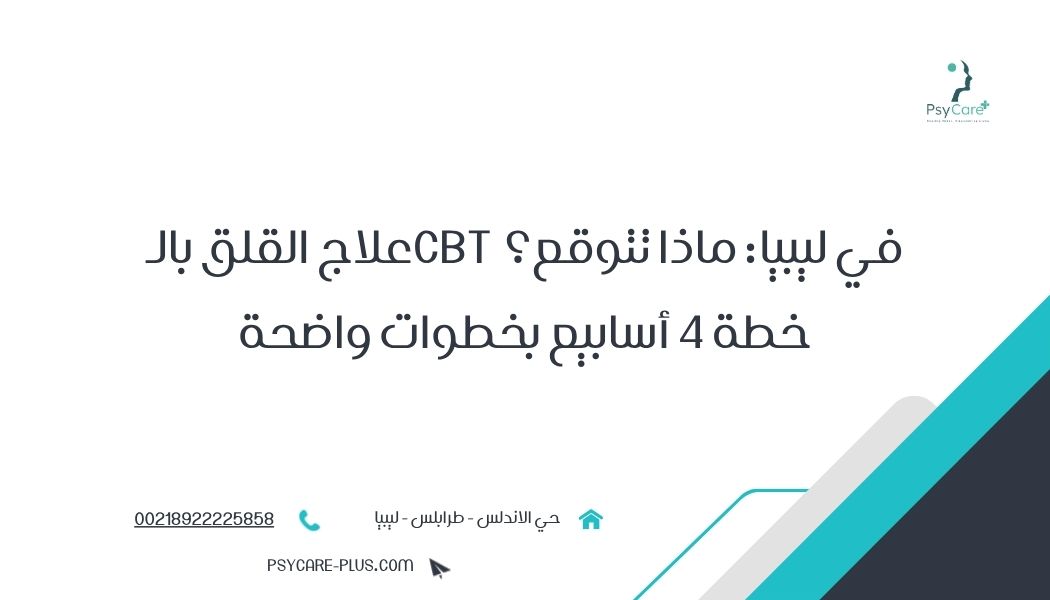CBT for Anxiety in Libya: What to Expect — A Clear 4-Week Plan
From Structured Assessment & Measurable Goals to Graded Exposure and Ritual Blocking

CBT for Anxiety in Libya: What to Expect — A Clear 4-Week Plan
Note: Educational support, not an emergency service. For acute risk, contact local emergency support first. For structured care: Therapists — Who We Are — Blog — Contact Us — PyCare Plus on Google Play.
Why CBT for anxiety?
Anxiety thrives on a loop: catastrophic thoughts → body arousal → safety behaviors (avoidance/reassurance/checking) → short relief → stronger anxiety later.
CBT breaks the loop via three levers: balanced thinking, body regulation, and behavior change (exposure + ritual blocking).
What to expect in Session 1
-
Guided assessment of triggers, symptoms, and safety behaviors.
-
A case map of what starts and maintains the loop.
-
Measurable goals (e.g., reduce meeting anxiety from 8/10 to 4/10 in 4–6 weeks).
-
A starter plan: brief calming skills, a simple thought record, the first graded exposure, and realistic homework.
Core CBT tools (plain language)
Psychoeducation
Differentiate real danger from a false alarm. Waves of anxiety rise and fall on their own—knowledge lowers catastrophic momentum.
Body regulation
-
4–6 breathing: inhale 4s/exhale 6s × 6–8 cycles.
-
5-4-3-2-1 grounding (or 3-2-1 short).
-
Sleep hygiene basics + taper afternoon stimulants.
Cognitive restructuring (CR)
Catch the thought → test evidence → write a balanced line → take a small action.
-
Thought: “If I speak, I’ll crash.”
-
Counter: past talks went okay; I have a one-line opener.
-
Balanced line: “Anxiety is normal—I’ll read my opener and continue.”
-
Action: one question/comment in the meeting.
Graded exposure
Approach feared situations systematically: start with the easiest slice, then increase duration/complexity.
-
Add interoceptive exposure (evoking benign bodily sensations) with ritual blocking.
Ritual blocking
Reduce/stop checking/escape/reassurance during exposure so the brain re-learns: “no danger, wave subsides.”
Smart homework
Tiny, daily tasks (5–10 minutes) with weekly progress checks.
Worry time (for GAD)
Schedule 15–20 minutes daily. During the day, jot titles only. In the slot, decide: one micro action today or allow uncertainty and revisit tomorrow. This bounds rumination and frees attention.
Exposure ladder — social anxiety (work example)
-
Post a brief message without re-reading.
-
Clear greeting at the start of a meeting.
-
One simple question.
-
One-minute point.
-
3–5 minute contribution.
Rule: climb one rung every 1–2 days, with 4–6 breathing and no reassurance.
Two-line thought record (fast)
-
Situation: morning meeting.
-
Thought: “I’ll freeze.” — Balanced: “Normal to be tense… I’ll read my opener.”
-
Action: gave opener + asked one question.
-
Result: anxiety 6→4 in ~7 minutes.
4-Week plan (customizable)
Week 1 — Foundations
-
Learn 4–6 breathing + 3-2-1 grounding.
-
Identify 3 safety behaviors; trim 30–50%.
-
Build a 5-rung exposure ladder for one core context.
-
Daily: one thought/balance/action note.
Week 2 — Easy exposures + ritual blocking
-
Do two easy rungs with a specified ritual blocked (e.g., zero pulse checks).
-
Start worry time PM.
-
Weekly review: wins, friction points.
Week 3 — Increase dose & generalize
-
Two harder rungs (7–10 minutes; larger context).
-
Generalize times/locations.
-
Try light interoceptive drill 30–45s after clinician’s approval.
Week 4 — Hardest rung + relapse prevention
-
Final rung.
-
Maintenance: 2–3 short exposures/week; early-warning list for reassurance/avoidance revival.
-
If warning signs appear, step down one rung, re-climb.
Progress markers: lower peaks, longer stay in contexts, less reassurance, better sleep/function.
Everyday scripts
Traffic/crowd: slow for two minutes + 4/6, continue.
Gathering: stay two extra minutes before leaving.
Busy shop: start near exit aisle, move inward next visit.
Body cues: brief interoceptive drill + no checking.
FAQs
Medication? Case-by-case with a psychiatrist when indicated.
Is online CBT effective? Yes—clear steps, tiny homework, consistent follow-up.
When will I notice change? Many see shifts within 2–4 weeks with steady practice.
Start now
-
Download & book CBT: PyCare Plus — Google Play
-
Choose your clinician: Therapists
-
Learn our ethos: Who We Are
-
Read more skills: Blog
-
Questions? Contact Us
Final CTA: Clear steps + one daily action = weaker anxiety loops. We’ll guide you, one rung at a time.




